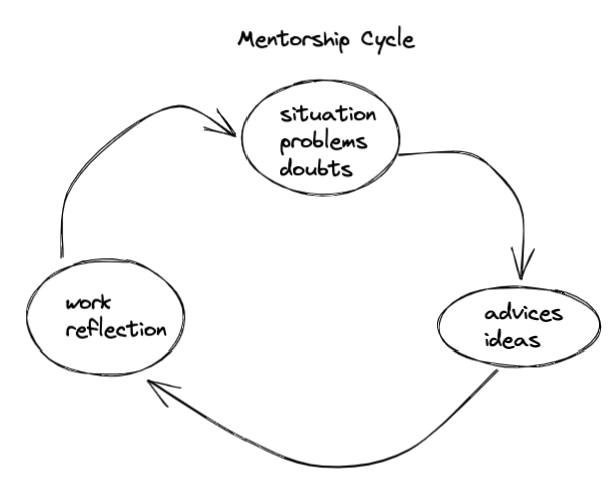- Learn how Canvas works
- Learn how Create a scene
- Learn how to Positining elements in a scene
- Learn how to create 3D elements using code
- Learn how to use 3D assets, textures, maps HDRIs
- Learn how to interact based on events, click, scroll, drag
- Learn how Animate elements - Frames
- Learn how Map WebGL elements to DOM elements whilst scrolling
- Learn how Preload and prerender textures (replicates AssetLoader)
- Learn how Manage WebGL resources (create and destroy materials and geometries as needed)
| { | |
| "scripts": { | |
| "build": "tsup", | |
| "dev": "yarn build --onSuccess \"yarn start\"", | |
| "dev:watch": "yarn dev --watch", | |
| "start": "node dist/index.js", | |
| }, | |
| "devDependencies": { | |
| "tsup": "^5.11.13", | |
| "typescript": "4.5.5" |
Most mentees belive that they need sync mentorship to be able to explain their problems. However, I've found that doing an async mentorship using text to provide better results. Mentorship is a long term process, you can't "fix" or "improve" someone in a session, it takes time.
The mentee will pass in the 3 steps of the mentorship cycle. The first one is to be in a given situation, or having some problem or doubt.
| function chunk(n: number, xs: number[]) { | |
| if (!xs.length) return []; | |
| return [xs.slice(0, n), ...chunk(n, xs.slice(n))]; | |
| } |
| import nodemailer, { Transporter } from 'nodemailer' | |
| import fs from 'fs'; | |
| import handlebars from 'handlebars'; | |
| import { SES } from 'aws-sdk' | |
| import { SESClient, SendEmailCommand } from '@aws-sdk/client-ses'; | |
| import { IMailParams, IMailProvider } from '../protocols/IMailProvider'; | |
| import { config } from '@config/config'; |
| // contracts/NFT.sol | |
| // SPDX-License-Identifier: MIT OR Apache-2.0 | |
| pragma solidity ^0.8.3; | |
| import "@openzeppelin/contracts/utils/Counters.sol"; | |
| import "@openzeppelin/contracts/token/ERC721/extensions/ERC721URIStorage.sol"; | |
| import "@openzeppelin/contracts/token/ERC721/ERC721.sol"; | |
| import "hardhat/console.sol"; |
Looking for the First Job
This is a very common state for people in college, people before/after a bootcamp, or people from another area.
The first job will be the hardest one to get, but it will get easier over time.
The interview will be harder than the job itself
| import Redis, { KeyType, Ok } from 'ioredis'; | |
| const redis = new Redis(process.env.REDIS_HOST); | |
| export const set = async ( | |
| key: KeyType, | |
| seconds: number, | |
| value: Record<string, unknown>, | |
| ): Promise<Ok> => | |
| // https://redis.io/commands/psetex |
The package that linked you here is now pure ESM. It cannot be require()'d from CommonJS.
This means you have the following choices:
- Use ESM yourself. (preferred)
Useimport foo from 'foo'instead ofconst foo = require('foo')to import the package. You also need to put"type": "module"in your package.json and more. Follow the below guide. - If the package is used in an async context, you could use
await import(…)from CommonJS instead ofrequire(…). - Stay on the existing version of the package until you can move to ESM.
